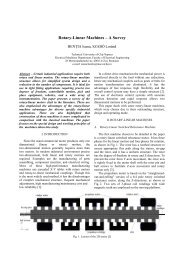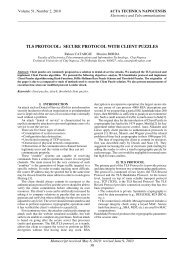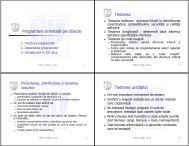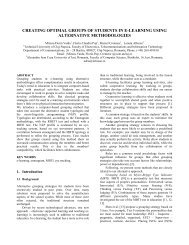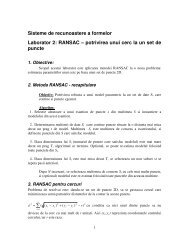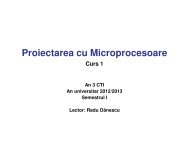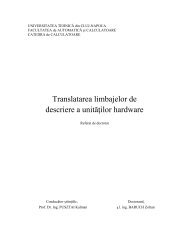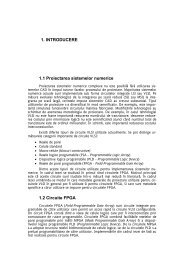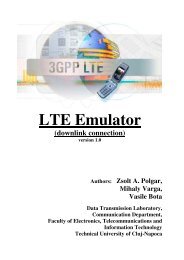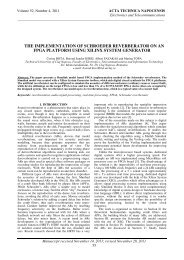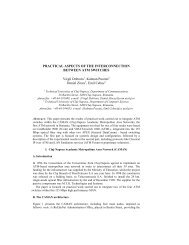Teza doctorat (pdf) - Universitatea Tehnică
Teza doctorat (pdf) - Universitatea Tehnică
Teza doctorat (pdf) - Universitatea Tehnică
Create successful ePaper yourself
Turn your PDF publications into a flip-book with our unique Google optimized e-Paper software.
WSEAS TRANSACTIONS ON COMMUNICATIONS Ovidiu Buza, Gavril Toderean<br />
(A) The basic set shows the general<br />
decomposition rules for Romanian. First rule is<br />
that a syllable consists of a sequence of consonants<br />
followed by a vowel:<br />
syllable ={CONS}*{VOC} (R1)<br />
Second rule statues that a syllable can be<br />
finished by a consonant if the beginning of the next<br />
syllable is also a consonant:<br />
syllable={CONS}*{VOC}{CONS}/{CONS}(R2)<br />
Third rule says that one or more consonants can<br />
be placed at the final part of a syllable if this is the<br />
last syllable of a word :<br />
syllable={CONS}*{VOC}{CONS}*/{SEP}(R3)<br />
(B) The exception set is made up from the rules<br />
that are exceptions from the three rules of above.<br />
These exceptions are situated in the front of basic<br />
rules. If no rule from the exception set is matched,<br />
then the syllable is treated by the basic rules. At<br />
this time, the exception set is made up by more<br />
then 100 rules. Rules are grouped in subsets that<br />
refer to resembling character sequences. All these<br />
rules are explained in [7], [8].<br />
4 Syllable Accentuation<br />
The principle for determining syllable accentuation<br />
is shown in the following diagram:<br />
WORD<br />
Text<br />
Parser<br />
F1 F2 ... Fk S<br />
Phonetic<br />
Rules<br />
Phonetic<br />
Analyzer<br />
STRESS<br />
Fig.4. The principle of detecting syllable<br />
accentuation<br />
Sn-3<br />
Sn-2<br />
Sn-1<br />
The parser returns current word from input<br />
stream. The word consists of series of phonemes<br />
F1, F2, …, Fk and is delimited by a separator S.<br />
Sn<br />
323<br />
Phonetic analyser reads this word and detects<br />
syllable accentuation based on phonetic rules.<br />
In Romanian, stressed syllable can be one of<br />
last four syllables of the word: Sn, Sn-1, Sn-2 or Sn-3, (<br />
Sn is the last syllable). Most often, stress is placed<br />
at last but one position.<br />
The rules set consists of this general rule (Sn-1<br />
syllable is stressed):<br />
{LIT}+/{SEP} { return(SN_1);}<br />
and a consistent set of exceptions, organized in<br />
classes of words having the same termination. In<br />
[7] one can find the complete set of rules.<br />
5 High Level Analysis<br />
High-level analyser takes low-level information:<br />
syllables, special characters and numbers from the<br />
lexical analysis module and constructs high-level<br />
structures: words and sentences.<br />
High-level analysis module takes a regular<br />
production rules set which specifies the syntax of<br />
input text. Input text is considered to be a set of<br />
sentences, each sentence – a set of words and each<br />
word is composed by one, two or more syllables.<br />
Sentences, and words respectively, are bounded by<br />
separators.<br />
Hierarchical structure of high-level units is<br />
presented in figure no.5. In this diagram, greyed<br />
units (syllables, numbers and separators) are the<br />
outcome of lexical analyser. Thereby, high-level<br />
or syntactical analyser module invokes lexical<br />
analyser for providing next lexical unit from input<br />
text: a syllable, a number or a separator.<br />
Based on the lexical units, at this level are<br />
formed syntactical units as words, sentences and<br />
text. High-level analyser also has the capability to<br />
call, for each syntactical unit separated from text, a<br />
specific subroutine from processing shell module.<br />
In our implementation, words and sentences are<br />
processed by calling two subroutines from<br />
processing shell: Process_Word and<br />
Process_Sentence.<br />
Based on corresponding terminators, at this<br />
level, sentences are classified as regular,<br />
imperative or interrogative. Such a classification is<br />
very important for modifying speech prosody (in<br />
future developments).



